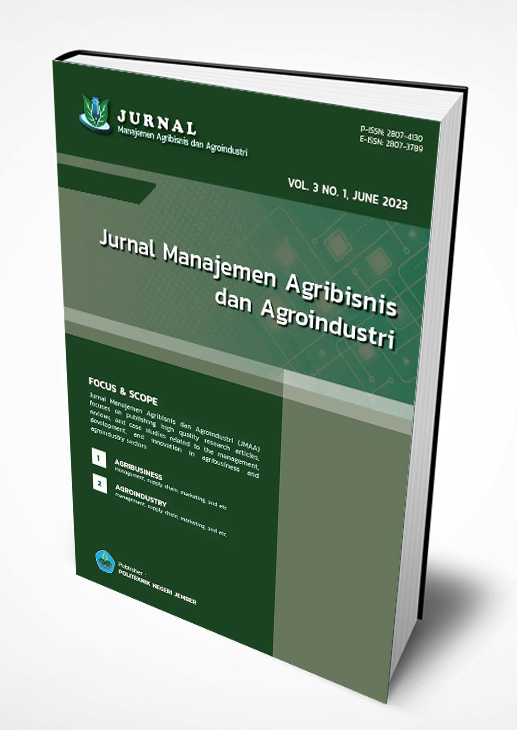Financial Savvy Unleashed: The Key Role of Knowledge, Behavior, and Access to Finance in Boosting MSME’s Success
DOI:
10.25047/jmaa.v5i1.100Downloads
Abstract
The issue of Sustainable Development Goals (SDGs) has a direct impact on the increase of a country’s Gross Domestic Product (GDP), particularly in the tourism sector. The growth of Micro, Small, and Medium Enterprises (MSMEs) has become a key factor in the success of this increase. However, capital constraints remain a challenge in unlocking the potential of MSMEs. Many MSME business owners are still not bankable and lack confidence in accessing capital. The purpose of this study is to examine the relationship between financial knowledge, financial behavior, access to finance, and firm performance among MSME owners in the thematic villages of Malang City. Using an explanatory research approach, the data collected were analyzed through SEM-PLS. The findings show that financial knowledge and financial behavior have a significant effect on firm performance, while access to finance does not influence firm performance.
Keywords:
financial knowledge , financial behavior , financial risk attitude , firm performanceReferences
Adomako, S., & Danso, A. (2014). Financial Literacy and Firm performance : The and resource flexibility. International Journal of Management & Organizational Studies, 3(4), 2–15.
Adomako, S., Danso, A., & Ofori Damoah, J. (2016). The moderating influence of financial literacy on the relationship between access to finance and firm growth in Ghana. Venture Capital, 18(1), 43–61. https://doi.org/10.1080/13691066.2015.1079952
Badan Pusat Statistik. (2024). Jumlah Devisa Sektor Pariwisata Tahun 2018-2020.
Barney, J. (1991). Firm Resources and Sustained Competitive Advantage. Journal of Management. https://doi.org/10.1177/014920639101700108
Beck, T., & Demirguc-Kunt, A. (2006). Small and medium-size enterprises: Access to finance as a growth constraint. Journal of Banking and Finance, 30(11), 2931–2943. https://doi.org/10.1016/j.jbankfin.2006.05.009
Chin, W. W. (1998). The partial least squares approach for structural equation modeling. In G. A. Marcoulides (Ed.), Modern methods for business research (Issue April, pp. 295–336). Lawrence Erlbaum Associates Publisher. https://www.researchgate.net/publication/311766005%0AThe
Cooper, D. R., & Schindler, P. S. (2014). Business Research Methods. In Business Research Methods (12th Editi). McGraw-Hill.
Depkop. (2018). Perkembangan Data Usaha Mikro , Kecil , Menengah Dan Usaha Besar. Www.Depkop.Go.Id, 2000(1), 1.
Eniola, A. A., & Entebang, H. (2015). Financial literacy and SME firm performance. International Journal of Research Studies in Management, 5(1), 31–43. https://doi.org/10.5861/ijrsm.2015.1304
Eniola, A., & Ektebang, H. (2014). SME firms performance in Nigeria: Competitive advantage and its impact. International Journal of Research Studies in Management. https://doi.org/10.5861/ijrsm.2014.854
Frimpong, S. E., Agyapong, G., & Agyapong, D. (2022). Financial literacy, access to digital finance and performance of SMEs: Evidence From Central region of Ghana. Cogent Economics and Finance, 10(1). https://doi.org/10.1080/23322039.2022.2121356
Grillitsch, M., Schubert, T., & Srholec, M. (2019). Knowledge base combinations and firm growth. Research Policy, 48(1), 234–247. https://doi.org/10.1016/j.respol.2018.08.009
Hair, J. F., Hult, G. T. M., Ringle, C. M., & Sarstedt, M. (2014). A PRIMER ON PARTIAL LEAST SQUARES STRUCTURAL EQUATION MODELING (PLS-SEM). In SAGE Publications, Inc. (2nd ed.). SAGE Publications Ltd. https://linkinghub.elsevier.com/retrieve/pii/S0024630113000034
Hussain, J., Salia, S., & Karim, A. (2018). Is knowledge that powerful? Financial literacy and access to finance: An analysis of enterprises in the UK. Journal of Small Business and Enterprise Development, 25(6), 985–1003. https://doi.org/10.1108/JSBED-01-2018-0021
JR., J. F. H., Hult, G. T. M., Ringle, C. M., & Sarstedt, M. (2022). A Primer on Partial Least Squares Structural Equation Modeling (PLS-SEM) Third Edition (3th ed.). Sage Publisher.
Kaban, R. F., & Safitry, M. (2020). DOES FINANCIAL LITERACY EFFECT TO PERFOMANCE AND SUSTAINABILITY OF CULINARY MSMEs IN GREATER JAKARTA? Ekonomi Bisnis, 25(1), 1. https://doi.org/10.17977/um042v25i1p1-13
Kachlami, H., & Yazdanfar, D. (2016). Determinants of SME growth: The influence of financing pattern. An empirical study based on Swedish data. Management Research Review. https://doi.org/10.1108/MRR-04-2015-0093
KEMENKOPUKM. (2018). Perkembangan Data Usaha Mikro , Kecil , Menengah Dan Usaha Besar. Www.Depkop.Go.Id, 2000(1), 1.
Krištofík, P., & Novotná, M. (2018). The Impact of Behavioral Finance on the Financial Performance of an Enterprise. In European Financial Systems 2018 of the 15 th International Scientific Conference.
Kumar, A. (2004). Access to Financial Services in Brazil. In Access to Financial Services in Brazil. https://doi.org/10.1596/0-8213-5716-6
Latief, M. (2018). Masih Banyak Pelaku UMKM “Buta” Akuntansi. Money.Kompas.Com. https://money.kompas.com/read/2018/08/30/144531526/masih-banyak-pelaku-umkm-buta-akuntansi
Liao, C.-F., & Chun-Da, C. (2020). Financial Literacy and Mobile Payment Behaviors. Journal of Accounting and Finance, 20(7). https://doi.org/10.33423/jaf.v20i7.3814
Lim, T. S., Mail, R., Abd Karim, M. R., Ahmad Baharul Ulum, Z. K., Jaidi, J., & Noordin, R. (2018). A serial mediation model of financial knowledge on the intention to invest: The central role of risk perception and attitude. Journal of Behavioral and Experimental Finance, 20, 74–79. https://doi.org/10.1016/j.jbef.2018.08.001
Mabula, J. B., & Ping, H. D. (2018). Financial literacy of SME managers’ on access to finance and performance: The mediating role of financial service utilization. International Journal of Advanced Computer Science and Applications, 9(9), 32–41. https://doi.org/10.14569/ijacsa.2018.090905
Muafi. (2016). Analyzing fit in CSR strategy research in state-owned enterprises: Indonesia context. Journal of Industrial Engineering and Management, 9(1), 179–206. https://doi.org/10.3926/jiem.1729
Muafi, M., & Roostika, R. (2014). Organizational Performance and Competitive Advantage Determinants of Creative SMEs. Journal of Corporate Governance, Insurance, and Risk Management (JCGIRM), 1(2), 1–19. http://www.ejemjournal.com/EJEM_2014_Vol.1_No.2.pdf
Nandan, T., & Saurabh, K. (2016). Big-five personality traits, financial risk attitude and investment intentions: study on Generation Y. International Journal of Business Forecasting and Marketing Intelligence, 2(2), 128. https://doi.org/10.1504/ijbfmi.2016.078154
Ratri, N. (2017). Sulit Beri Suntikan Modal pada UMKM, Pemkot Malang Lakukan Ini. MalangTimes.Com. https://jatimtimes.com/baca/162515/20171128/104530/sulit-beri-suntikan-modal-pada-umkm-pemkot-malang-lakukan-ini
Santoso, P. I. (2018). Metode Penelitian Kuantitatif: Pengembangan Hipotesis dan Pengujiannya Menggunakan SmartPLS (Giovanny, Ed.; Ed. I.). Penerbit Andi.
Sekaran, U., & Bougie, R. (2016). Research Methods for Business: A Skill-Building Approach (Seventh ed). John Wiley & Sons Ltd.
Tuffour, J. K., Amoako, A. A., & Amartey, E. O. (2020). Assessing the Effect of Financial Literacy Among Managers on the Performance of Small-Scale Enterprises. Global Business Review. https://doi.org/10.1177/0972150919899753
United Nation. (2020). TARGETS AND INDICATORS. Goal 9: Build Resilient Infrastructure, Promote Inclusive and Sustainable Industrialization and Foster Innovation. https://sdgs.un.org/goals/goal9
van Rooij, M., Lusardi, A., & Alessie, R. (2011). Financial literacy and stock market participation. Journal of Financial Economics, 101(2), 449–472. https://doi.org/10.1016/j.jfineco.2011.03.006
Wachira, M., & Kihiu, E. (2012). Impact of financial literacy on access to financial services in Kenya. International Journal of Business and Social …, 3(19), 42–50. https://ijbssnet.com/journals/Vol_3_No_19_October_2012/5.pdf
Wati, C. R., Sumiati, S., & Andarwati, A. (2022). The effect of financial knowledge on firm performance. International Journal of Research in Business and Social Science (2147- 4478), 10(8), 236–249. https://doi.org/10.20525/ijrbs.v10i8.1450
Widyastuti, M., & Hermanto, Y. B. (2022). The effect of financial literacy and social media on micro capital through financial technology in the creative industry sector in East Java. Cogent Economics and Finance, 10(1). https://doi.org/10.1080/23322039.2022.2087647
Ye, J., & Kulathunga, K. M. M. C. B. (2019). How does financial literacy promote sustainability in SMEs? A developing country perspective. Sustainability (Switzerland), 11(10), 1–21. https://doi.org/10.3390/su11102990
Yong, C. C., Yew, S. Y., & Wee, C. K. (2018). Financial knowledge, attitude and behaviour of young working adults in Malaysia. Institutions and Economies, 10(4), 21–48. https://ijie.um.edu.my/index.php/ijie/article/view/13444
License
Copyright (c) 2025 Cicik R. Wati, Devi Artha Bonita, Ketut candra pangestu putra

This work is licensed under a Creative Commons Attribution 4.0 International License.
You are free to:
- Share — copy and redistribute the material in any medium or format for any purpose, even commercially.
- Adapt — remix, transform, and build upon the material for any purpose, even commercially.
The licensor cannot revoke these freedoms as long as you follow the license terms.
Under the following terms:
- Attribution — You must give appropriate credit, provide a link to the license, and indicate if changes were made. You may do so in any reasonable manner, but not in any way that suggests the licensor endorses you or your use.
- No additional restrictions — You may not apply legal terms or technological measures that legally restrict others from doing anything the license permits.
Notices:
You do not have to comply with the license for elements of the material in the public domain or where your use is permitted by an applicable exception or limitation.
No warranties are given. The license may not give you all of the permissions necessary for your intended use. For example, other rights such as publicity, privacy, or moral rights may limit how you use the material.






